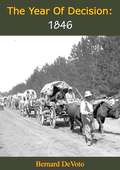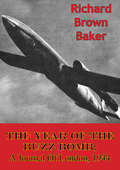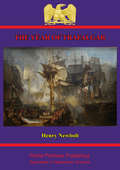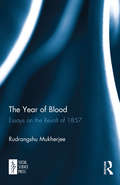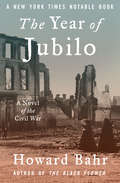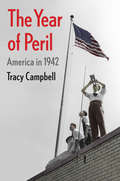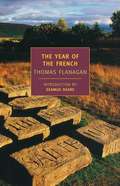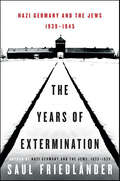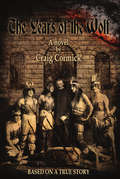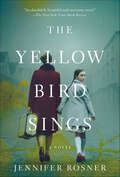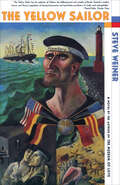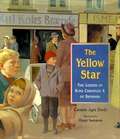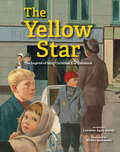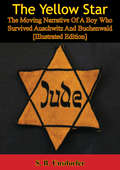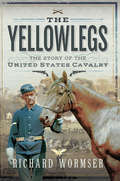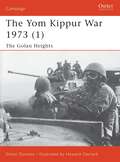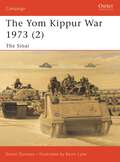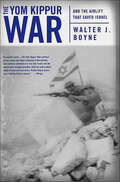- Table View
- List View
The Yanks Are Coming: The United States in the First World War
by Albert MarrinDescribes how American military forces helped the Allies turn the tide of World War I and how the United States mobilized industry, trained soldiers, and promoted the war to the people at home.
The Year Of Decision: 1846
by Bernard DevotoThis book tells many fascinating stories of the U.S. explorers who began the Western march from the Mississippi to the Pacific, from Canada to the annexation of Texas, California, and the Southwest lands from Mexico. It is the penultimate book of a trilogy which includes Across the Wide Missouri, for which DeVoto won both the Pulitzer and Bancroft prizes in 1948, and The Course of Empire, which won the National Book Award for Nonfiction in 1953. DeVoto's narrative covers the expanding Western frontier, the Mormons, the Donner party, Fremont's exploration, the Army of the West, and takes readers into Native American tribal life.
The Year Of The Buzz Bomb; A Journal Of London, 1944: A Journal Of London 1944
by Richard Brown BakerOne humble GI working for the OSS in London recounts his experiences under bombardment by the Nazi wonder-weapon, the V-1 flying rocket."London in April and May of 1944 was a battered, cheered hero. The whole Allied world admired the fortitude of its inhabitants, survivors of the fires and explosions of persistent Luftwaffe attacks."It was to this London that I came as one of the innumerable Americans shipped overseas for the war effort, having crossed the Atlantic on the crowded Queen Mary, nearly fifteen thousand troops aboard, which sped out of submarine range into a Scottish port toward the end of March. We came, a batch of us, by night in a darkened troop-train to London, where we arrived in a gray dawn as one of the last of the "Little Blitz" air attacks was ending."After 1944's balmy, agreeable April the weather worsened. Then by mid-June began the prolonged and terrifying bombardment of London by flying bombs (nicknamed also V-1, buzz bombs, doodle bugs, rocket bombs, and pilotless planes) that were launched from across the English Channel."
The Year Of Trafalgar
by Sir John Henry NewboltA happy idea carried to excellent completion by very competent hands is the best description of The Year of Trafalgar, by Henry Newbolt. It is not likely that this year of splendid memory will find a worthier literary tribute than this delightful volume. Mr. Newbolt's is much more than a familiar story, gracefully retold. He has made an exhaustive study of all the details of the Naval Campaign of 1805, and his narrative is of distinct historical value. As might have been expected, Mr. Newbolt writes with deliberate sobriety and restraint. Great deeds are best told simply, and the last glorious chapter in the life of Nelson needs no literary embellishment. Every danger besetting a task full of difficulty is evaded. He is not laboured, nor pedantic, nor sentimental, but rather tells the great story in a direct and manly way, eminently befitting the subject. His is a book which every boy should read in "Nelson's year," and no Briton of any age will read it unmoved. It was a happy thought to add to the narrative an anthology of Trafalgar poetry. It is a little curious, as Mr. Newbolt points out, how our greatest warlike achievements have received scant treatment from our poets. The "Victory " has been less fortunate than "The Revenge" or "The Temeraire." Strange that it did not rouse the war-bugle of Campbell to an immortal strain. Of all the verses, Mr. Newbolt's own are perhaps the best. Some day, we trust, he will give us a song of Nelson to rank in all future patriotic anthologies with his incomparable "Drake's Drum," "The Fighting Temeraire," and "The Ballad of the Bold Menelaus."--The Bookman 1905.
The Year of Blood: Essays on the Revolt of 1857
by Rudrangshu MukherjeeRudrangshu Mukherjee places the ‘soldier-peasant’ at the forefront of the Revolt. Violence has rarely been described with so much realism and subtlety. The imaginative use of primary source materials adds clarity to accounts such as the massacre in Satichaura Ghat and the trial of Mangal Pandey. The layers of complexity that defined the relationship between the rulers and the subjugated are also exposed.
The Year of Europe: Documents on British Policy Overseas, Series III Volume IV (Whitehall Histories Ser. #Vol. Iii)
by Christopher Baxter Keith Hamilton Patrick Salmon Alastair NobleThis is the latest volume of Documents on British Policy Overseas and the first in the series to be produced in electronic format, covering the principal themes of: the European Union, transatlantic divisions, war in the Middle East and the diplomacy of the energy crisis. Edited and selected by Foreign and Commonwealth Office historians, it consist
The Year of Jubilo: A Novel of the Civil War
by Howard BahrA &“sweeping, cinematic story of rebellion, loyalty, revenge, and reawakened romance&” set in the immediate aftermath of the Civil War (The New York Times Book Review). A New York Times Notable Book The last time Gawain Harper saw Cumberland, Mississippi, he was heading off to fight for the newly formed Confederate States of America—driven not by the cause that motivated so many others, but by love. The father of his beloved, Morgan Rhea, refused to allow her to be courted by a man who would not take up arms to defend the South. So Gawain joined the Mississippi Infantry—and now, three nightmarish years later, he is coming home. But postwar Cumberland is not the place Gawain so fondly remembered. An occupying force of Union soldiers keeps uneasy watch over the townspeople, including an erstwhile slave hunter and an albino gravedigger known as Old Hundred-and-Eleven. Meanwhile, a bloodthirsty former Confederate officer named King Solomon Gault is organizing a secret militia to drive the occupiers out and bring the entire region under his ruthless control. Before Gawain can marry Morgan and build their new life together, he must return to the world of violence and turmoil he has been so desperate to escape. With &“complex, well-crafted, often beautiful prose&” (TheSeattle Times) and &“a cast of characters worthy of a Larry McMurtry novel&” (Newsday), The Year of Jubilo is a stunning achievement from the award-winning author of The Black Flower and The Judas Field.
The Year of Peril: America in 1942
by Tracy CampbellA fascinating chronicle of how the character of American society revealed itself under the duress of World War II The Second World War exists in the American historical imagination as a time of unity and optimism. In 1942, however, after a series of defeats in the Pacific and the struggle to establish a beachhead on the European front, America seemed to be on the brink of defeat and was beginning to splinter from within. Exploring this precarious moment, Tracy Campbell paints a portrait of the deep social, economic, and political fault lines that pitted factions of citizens against each other in the post–Pearl Harbor era, even as the nation mobilized, government‑aided industrial infrastructure blossomed, and parents sent their sons off to war. This captivating look at how American society responded to the greatest stress experienced since the Civil War reveals the various ways, both good and bad, that the trauma of 1942 forced Americans to redefine their relationship with democracy in ways that continue to affect us today.
The Year of the French (The Thomas Flanagan Trilogy)
by Seamus Deane Thomas FlanaganIn 1798, Irish patriots, committed to freeing their country from England, landed with a company of French troops in County Mayo, in westernmost Ireland. They were supposed to be an advance guard, followed by other French ships with the leader of the rebellion, Wolfe Tone. Briefly they triumphed, raising hopes among the impoverished local peasantry and gathering a group of supporters. But before long the insurgency collapsed in the face of a brutal English counterattack.Very few books succeed in registering the sudden terrible impact of historical events; Thomas Flanagan's is one. Subtly conceived, masterfully paced, with a wide and memorable cast of characters, The Year of the French brings to life peasants and landlords, Protestants and Catholics, along with old and abiding questions of secular and religious commitments, empire, occupation, and rebellion. It is quite simply a great historical novel.Named the most distinguished work of fiction in 1979 by the National Book Critics' Circle.
The Year of the Wind: A Novel
by Karina Pacheco MedranoA lyrical novel depicting the devastating effects of political violence in Peru on three women’s livesNina, a Peruvian writer in Spain on the eve of the pandemic, is pulled back into her nation’s fraught history after a fleeting encounter with a woman who is a doppelgänger of Bárbara, a cousin lost to time. The games, the candor, and the secrets of her youth come alive again, but these memories are tinged with disquiet, and what unfolds takes Nina back to a village nestled in the Andes where she must confront the terrors that stalked Peru in the early 1980s. As she travels from Cusco to Apurimac to uncover Bárbara’s fate, Nina begins to weave a new cloth of memory. She learns more about Bárbara’s political radicalization and involvement with the Shining Path, the Maoist terrorist group that instigated a bloody period of political violence in which tens of thousands of mostly indigenous Peruvians disappeared or were killed.In her first novel to be translated into English, Karina Pacheco Medrano explores how war transforms family stories and complicates the distinction between prey and hunter. Part bildungsroman, part detective novel, The Year of the Wind records a significant chapter in Peruvian history rarely considered in the literature of political violence, exploring the anonymous stories marked by horror, loss, bewilderment, and, in some cases, redemption.
The Years Were Good
by Louis B. SeltzerLOUIS BENSON SELTZER was born September 19, 1897, in a single-story cottage back of a fire station on Cleveland’s near West Side—on the other side of the river and the other side of the tracks. The oldest of five children in a household always short of cash, he was hardly in knee britches before he was handling a paper route to help out the kitchen bank. His father was Charles Alden Seltzer, who was to write 49 books, many of which were later made into motion pictures. But when Louis Seltzer was seven years old his father had not yet sold his first story, and when he was thirteen he left school without finishing seventh grade in order to take a job as an office boy and cub reporter on The Leader. A year later he moved over to The Cleveland News, only to come back to The Leader where, in addition to his other duties, he wrote a column under the by-line of “Luee, The Offis Boy.” Once more he shifted to The Cleveland News, and after a short time there he was fired—and told he’d never make a newspaperman.This was early in 1915 and Louis B. Seltzer was not quite eighteen. He was already married to Marion Elizabeth Champlin, and his first child, Chester Ellsworth, was soon to be born. A daughter, Shirley Marion, was born in 1919. Within a year of joining The Press he was made City Editor, only to fire himself from that particular assignment in six months because he didn’t like the desk work. He chose to become a reporter again, specializing in the political beat.In 1921 he again became City Editor of The Press. In 1924 he was named Political Editor. In 1927 he was made Chief Editorial Writer. In March of 1928 he became Associate Editor. And on July 9, in the same year, he was elevated to the post of Editor of The Cleveland Press, a position he has filled ever since. In addition he has been since 1937 Editor-in-Chief of the Scripps-Howard Newspapers of Ohio.
The Years of Extermination: Nazi Germany and the Jews, 1939–1945
by Saul Friedländer"Establishes itself as the standard historical work on Nazi Germany’s mass murder of Europe’s Jews. . . . An account of unparalleled vividness and power that reads like a novel. . . . A masterpiece that will endure." — New York Times Book ReviewThe Years of Extermination, the completion of Saul Friedländer's major historical opus on Nazi Germany and the Jews, explores the convergence of the various aspects of the Holocaust, the most systematic and sustained of modern genocides.The enactment of the German extermination policies that resulted in the murder of six million European Jews depended upon many factors, including the cooperation of local authorities and police departments, and the passivity of the populations, primarily of their political and spiritual elites. Necessary also was the victims' willingness to submit, often with the hope of surviving long enough to escape the German vise.In this unparalleled work—based on a vast array of documents and an overwhelming choir of voices from diaries, letters, and memoirs—the history of the Holocaust has found its definitive representation.
The Years of the Wolf
by Craig CormickThis story begins with a murder. A German internee is found dead inside a civilian internment camp during World War One, and one young internee, Arno Friedrich, determines to find the killer. But the more he probes into the lives of his fellow internees the more he discovers that little within the old stone prison is as he had imagined. He finds that the Germanic facades and fantasies the men construct hide secrets within secrets. And a killer.
The Yellow Bird Sings: A Novel
by Jennifer RosnerNational Jewish Book Award Finalist "Rosner’s exquisite, heart-rending debut novel is proof that there’s always going to be room for another story about World War II....This is an absolutely beautiful and necessary novel, full of heartbreak but also hope, about the bond between mother and daughter, and the sacrifices made for love." —The New York TimesIn Poland, as World War II rages, a mother hides with her young daughter, a musical prodigy whose slightest sound may cost them their lives.As Nazi soldiers round up the Jews in their town, Róza and her 5-year-old daughter, Shira, flee, seeking shelter in a neighbor’s barn. Hidden in the hayloft day and night, Shira struggles to stay still and quiet, as music pulses through her and the farmyard outside beckons. To soothe her daughter and pass the time, Róza tells her a story about a girl in an enchanted garden:The girl is forbidden from making a sound, so the yellow bird sings. He sings whatever the girl composes in her head: high-pitched trills of piccolo; low-throated growls of contrabassoon. Music helps the flowers bloom. In this make-believe world, Róza can shield Shira from the horrors that surround them. But the day comes when their haven is no longer safe, and Róza must make an impossible choice: whether to keep Shira by her side or give her the chance to survive apart.Inspired by the true stories of Jewish children hidden during World War II, Jennifer Rosner’s debut is a breathtaking novel about the unbreakable bond between a mother and a daughter. Beautiful and riveting, The Yellow Bird Sings is a testament to the triumph of hope—a whispered story, a bird’s song—in even the darkest of times.
The Yellow Birds
by Kevin PowersAn unforgettable depiction of the psychological impact of war, by a young Iraq veteran and poet, THE YELLOW BIRDS is already being hailed as a modern classic. It is also a story of love, of great courage, and of extraordinary human survival. WINNER OF THE GUARDIAN FIRST BOOK AWARD NATIONAL BOOK AWARD FINALISTNEW YORK TIMES BESTSELLER and BOOK OF THE YEARA TLS, GUARDIAN, EVENING STANDARD and SUNDAY HERALD BOOK OF THE YEAREverywhere John looks, he sees Murph.He flinches when cars drive past. His fingers clasp around the rifle he hasn't held for months. Wide-eyed strangers praise him as a hero, but he can feel himself disappearing. Back home after a year in Iraq, memories swarm around him: bodies burning in the crisp morning air. Sunlight falling through branches; bullets kicking up dust; ripples on a pond wavering like plucked strings. The promise he made, to a young man's mother, that her son would be brought home safely.Written with profound emotional insight, especially into the effects of a hidden war on families at home, THE YELLOW BIRDS is one of the most haunting, true and powerful novels of our time.
The Yellow Birds: A Novel
by Kevin PowersWINNER OF THE GUARDIAN FIRST BOOK AWARD 2012WINNER OF THE HEMINGWAY/PEN AWARD 2012NATIONAL BOOK AWARD FINALISTAN AMAZON EDITOR'S PICK: BEST BOOKS OF 2012 A NEW YORK TIMES TOP TEN BOOK OF THE YEARA TIMES BOOK OF THE YEARAN INDEPENDENT BOOK OF THE YEAR A TLS BOOK OF THE YEARAN EVENING STANDARD BOOK OF THE YEARA SUNDAY EXPRESS BOOK OF THE YEARA GUARDIAN BOOK OF THE YEAR A NEW YORK TIMES BOOK OF THE YEARA SUNDAY HERALD BOOK OF THE YEARAN IRISH TIMES BOOK OF THE YEAR An unforgettable depiction of the psychological impact of war, by a young Iraq veteran and poet, THE YELLOW BIRDS is already being hailed as a modern classic.Everywhere John looks, he sees Murph.He flinches when cars drive past. His fingers clasp around the rifle he hasn't held for months. Wide-eyed strangers praise him as a hero, but he can feel himself disappearing. Back home after a year in Iraq, memories swarm around him: bodies burning in the crisp morning air. Sunlight falling through branches; bullets kicking up dust; ripples on a pond wavering like plucked strings. The promise he made, to a young man's mother, that her son would be brought home safely.With THE YELLOW BIRDS, poet and veteran Kevin Powers has composed an unforgettable account of friendship and loss. It vividly captures the desperation and brutality of war, and its terrible after-effects. But it is also a story of love, of great courage, and of extraordinary human survival. Written with profound emotional insight, especially into the effects of a hidden war on families at home, THE YELLOW BIRDS is one of the most haunting, true and powerful novels of our time.'THE YELLOW BIRDS is the All Quiet on the Western Front of America's Arab Wars.'(Tom Wolfe, author of The Bonfire of the Vanities )'Kevin Powers has conjured a poetic and devastating account of war's effect on the individual.'(Damian Lewis, star of Homeland and Band of Brothers )'Inexplicably beautiful'.(Ann Patchett, Orange Prize-winning author of Bel Canto and State of Wonder)(P)2012 Hachette Audio
The Yellow Birds: A Novel (Litterature & Documents Ser.)
by Kevin Powers<P>A novel written by a veteran of the war in Iraq, The Yellow Birds is the harrowing story of two young soldiers trying to stay alive. <P>"The war tried to kill us in the spring." <P> So begins this powerful account of friendship and loss. In Al Tafar, Iraq, twenty-one-year old Private Bartle and eighteen-year-old Private Murphy cling to life as their platoon launches a bloody battle for the city. Bound together since basic training when Bartle makes a promise to bring Murphy safely home, the two have been dropped into a war neither is prepared for. <P>In the endless days that follow, the two young soldiers do everything to protect each other from the forces that press in on every side: the insurgents, physical fatigue, and the mental stress that comes from constant danger. <P> As reality begins to blur into a hazy nightmare, Murphy becomes increasingly unmoored from the world around him and Bartle takes actions he could never have imagined. <P>With profound emotional insight, especially into the effects of a hidden war on mothers and families at home, The Yellow Birds is a groundbreaking novel that is destined to become a classic.
The Yellow Sailor: A Novel
by Steve WeinerIn this surreal & dramatic novel set at the dawn of World War I, a German merchant ship wrecks, and its crew of five drift their separate ways. This extraordinary novel, moodily operatic in tone and by turns hallucinatory and brilliantly detailed, follows the trajectories of four sailors and the owner of a German merchant ship, Yellow Sailor, which sets sail from Bremen in 1914. After the ship wrecks in shallow water, the men drift their separate ways, with each man&’s journey across a desolate wartime European landscape becoming an exploration of the failure of love, sex, religion, and friendship . . . Julius Bernai, owner of the ship and frankly homosexual, checks into an institute for nervous disorders and falls in love with the doctor&’s fiancée. Nicholas Bremml drifts: from the beds of numerous prostitutes to an oil tanker called Erwartung— Expectation—to Prague&’s Jewish market, where he sells magic spells. Brothers Karl and Alois are equally rudderless, and Jacek, the electrician, goes to work in the mines, where his love advice to a fourteen-year-old Polish boy precipitates a macabre murder . . .Praise for The Yellow Sailor &“The Yellow Sailor has the calamity of Voltaire, the disillusionment and venality of Brecht, Kasinski&’s random horror, and Grosz&’s population of leering businessmen and hard-bitten prostitutes. . . . It&’s bold and unforgettable.&” —David Finkle, Trenton Times
The Yellow Star: The Legend of King Christian X of Denmark
by Carmen Agra Deedy Henri SorensenWithout the yellow star to point them out, the Jews looked like any other Danes. For centuries, the Star of David was a symbol of Jewish pride. But during World War II, Nazis used the star to segregate and terrorize the Jewish people. Except in Denmark. When Nazi soldiers occupied his country, King Christian X of Denmark committed himself to keeping all Danes safe from harm. The bravery of the Danes and their king during that dangerous time has inspired many legends. The most enduring is the legend of the yellow star, which symbolizes the loyalty and fearless spirit of the king and his people. Award-winning author and storyteller Carmen Deedy has poignantly recreated this legend, which is accompanied by Danish illustrator Henri Sørensen's arresting full-color portraits. The result is a powerful and dignified story of heroic justice, a story for all people and all times.
The Yellow Star: The Legend of King Christian X of Denmark
by Carmen Agra DeedyWithout the yellow star to point them out, the Jews looked like any other Danes. In 1940, Nazis occupied Denmark and King Christian X, beloved amongst his people, had to find some way to resist their overwhelming power. When the order went out that all Jews must wear a yellow star on their clothes, the king had an idea that might just work. But it would take the faith and commitment of all Danes.In this retelling of a World War II legend, New York Times best-selling author Carmen Agra Deedy poignantly remind us of the power of a good, wise leader. Paired with Henri Sørensen's arresting full-color portraits, this is a powerful and dignified story of heroic justice.
The Yellow Star: The Moving Narrative Of A Boy Who Survived Auschwitz And Buchenwald [Illustrated Edition]
by S. B. UnsdorferIncludes 204 photos, plans and maps illustrating The Holocaust"Simcha Bunem Unsdorfer was the son of a well-known rabbi in Bratislava, the mother community for the Jewish population of Czechoslovakia. Because of the importance of his father's position, the family was permitted to remain in the city after the German occupation during World War II. Eventually, however, the family was deported to the infamous camps of Auschwitz where the Unsdorfers were separated and the parents killed. Their nineteen-year-old son Simcha was transferred from Auschwitz to work in an airplane factory in the Buchenwald camp. Throughout his long and terrible ordeal, he and his fellow prisoners were mercilessly molested by the S.S. men, but they held on to life tenaciously, their faith in God and His Torah never wavering. When the war finally ended, workers and prisoners were freed and permitted to go home. Home! Home! cried the Czechs, dancing and kissing in mad jubilation. We, the Jews, sank down on the floor again...Home Home What a travesty. Home a place that no longer was, and never would be again. Free...What were we freed for? Only to mourn and lament for the rest of our days over the greatest tragedy that had ever befallen our people in our long and trying history. Simcha Bunem Unsdorfer has written a deeply moving account of his experiences as a devout Jew in the concentration camps and factories of the Nazi Reich. The Yellow Star is a painful story, but a heroic one, a book which cogently describes the Divine strength inherent in the Jewish soul."-Print ed.
The Yellowlegs: The Story of the United States Cavalry
by Richard WormserThe colorful, action-packed early history of the horse-riding branch of the U.S. Army. In this comprehensive and lively account, Richard Wormser—who was himself an enthusiastic horseman—narrates the major events and characters of the U.S. Cavalry&’s formative, and, some might say fruitful, years. From the American Revolution and the exploits of men such as Henry &“Light-Horse Harry&” Lee III and Francis Marion, the first of the guerrillas, the author follows on with Stephen Kearny, the &“Father of the Cavalry&” whose dragoons went west to California on mules, and his nephew Philip, who organized the famed Gray Horse Troop of the Mexican War. Other famous names featured include Jonathan &“Stonewall&” Jackson; George Crook, who admired the Indians it was his duty to hunt down; and George Armstrong Custer. A U.S. Army officer and cavalry commander who served with distinction in the American Civil War, Custer is most remembered for leading more than 200 of his men to their deaths in the Battle of the Little Bighorn in June 1876. Also known as &“Custer&’s Last Stand&’, Bighorn was part of the Black Hills War against a confederation of Plains Indians, including the Cheyenne and Dakota Sioux. It remains one of the most controversial battles in American history. Roosevelt&’s Roughriders and Black Jack Pershing, who led his troops in an automobile, complete the narrative—one which is undoubtedly a saga of daring raids, of epic marches, and of grueling battles. As the author reveals, the story of the U.S. Cavalry is also the story of the birth and growth of America itself.
The Yom Kippur War 1973
by Howard Gerrard Simon DunstanOsprey's first title in the study of the Yom Kippur War (1973). At 1345hrs on 6 October 1973, Israeli spotters in the observation post atop Mount Hermon saw Syrian gunners below them removing the camouflage nets from their guns. Ten minutes later shells began to rain down on Israeli positions all along the Golan Heights - The Yom Kippur War had begun. The shock Syrian attack caught the Israelis by surprise and by the afternoon of 7 October a Syrian brigade was less than 10km from the Sea of Galilee. Simon Dunstan describes in detail how amid desperate and bitter fighting the Israeli forces managed to turn the tide on the Golan Heights.
The Yom Kippur War 1973
by Kevin Lyles Simon DunstanOsprey's second title in the study of the Yom Kippur War (1973). Israel's victory in the 1967 'Six Day War' sowed the seeds of the 1973 Yom Kippur War. At 1400hrs on 6 October 1973 the Egyptian army launched an assault crossing of the Suez Canal. The carefully co-ordinated attack achieved complete tactical surprise. The sand embankments of the Israeli Bar-Lev Line were breached and an Israeli counterattack thrown back with heavy losses. In the second of his two-volume analysis of the Yom Kippur War, Simon Dunstan details the fighting in the Sinai, culminating in Operation Gazelle, the Israeli counterattack across the Suez Canal. Although defeated militarily Egypt did ultimately succeed in forcing the Israelis back to the negotiating table.
The Yom Kippur War: And the Airlift Strike That Saved Israel
by Walter J. BoyneWalter J. Boyne's The Yom Kippur War is a spellbinding chronicle of the international chess game that was played out in October 1973. It is a story of diplomacy and military might that accounts for many of the dilemmas faced in the present-day Middle East. It's usually called the Yom Kippur War. Or sometimes the October War. The players that surround it are familiar: Sadat and Mubarak, Meir and Sharon, Nixon and Kissinger, Brezhnev and Dobyrnin. It was a war that brought Arab and Jew into vicious conflict. A war in which Israel almost unleashed her nuclear arsenal and set two superpowers on a treacherous course of nuclear escalation. And a war that eventually brought peace. But a peace fraught with delicate tensions, disputed borders, and a legacy of further bloodshed. This is a war that Israel never thought was possible. Surprised by the fury and excellent execution of the Arab onslaught, and perhaps more than a little complacent, Israel suddenly found itself on the point of losing a war because of a lack of ammunition, planes and tanks. The United States, after much vacillation, finally elected to help Israel, beginning a tremendous airlift (code name: Operation Nickel Grass) which incurred the wrath of the Arab states, and their sponsor, the Soviet Union. Fortunately, the airlift came just in time for Israeli ground forces to stabilize their positions and eventually turn the tide in the Sinai and Golan Heights. And it was all made possible by an operation that dwarfed the Berlin Airlift and the Soviets' simultaneous efforts in Egypt and Syria.The Yom Kippur War is bound to become the definitive history of a war that quite literally approached Armageddon.

